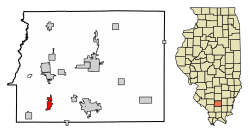Zeigler, Illinois
Zeigler is a city in Franklin County, Illinois, United States. The population was 1,801 at the 2010 census.[3] The current mayor is Dennis Mitchell.
Zeigler, Illinois | |
|---|---|
City | |
 Location of Zeigler in Franklin County, Illinois. | |
.svg.png) Location of Illinois in the United States | |
| Coordinates: 37°53′59″N 89°3′12″W | |
| Country | United States |
| State | Illinois |
| County | Franklin |
| Area | |
| • Total | 1.37 sq mi (3.54 km2) |
| • Land | 1.36 sq mi (3.52 km2) |
| • Water | 0.01 sq mi (0.02 km2) |
| Elevation | 412 ft (126 m) |
| Population (2010) | |
| • Total | 1,801 |
| • Estimate (2018)[2] | 1,725 |
| • Density | 1,286.98/sq mi (497.05/km2) |
| Time zone | UTC-6 (CST) |
| • Summer (DST) | UTC-5 (CDT) |
| ZIP Code(s) | 62999 |
| Area code(s) | 618 |
| FIPS code | 17-84155 |
| Website | cityofzeiglerillinois |
Geography
Zeigler is located in southwestern Franklin County at 37°53′59″N 89°3′12″W (37.899856, -89.053429).[4] Illinois Route 149 passes through the center of town, leading east 7.5 miles (12.1 km) to West Frankfort and west 4 miles (6 km) to Royalton. Interstate 57 is 6 miles (10 km) east of Zeigler via Route 149. Illinois Route 148 follows the western border of Zeigler, leading north 5 miles (8 km) to Christopher and south 7 miles (11 km) to Herrin.
According to the 2010 census, Zeigler has a total area of 1.357 square miles (3.51 km2), of which 1.35 square miles (3.50 km2) (or 99.48%) is land and 0.007 square miles (0.02 km2) (or 0.52%) is water.[5]
Demographics
| Historical population | |||
|---|---|---|---|
| Census | Pop. | %± | |
| 1920 | 2,338 | — | |
| 1930 | 3,816 | 63.2% | |
| 1940 | 3,006 | −21.2% | |
| 1950 | 2,516 | −16.3% | |
| 1960 | 2,133 | −15.2% | |
| 1970 | 1,940 | −9.0% | |
| 1980 | 1,858 | −4.2% | |
| 1990 | 1,746 | −6.0% | |
| 2000 | 1,669 | −4.4% | |
| 2010 | 1,801 | 7.9% | |
| Est. 2018 | 1,725 | [2] | −4.2% |
| U.S. Decennial Census[6] | |||
In 2005 James Leuwen characterized Ziegler as a "sundown town", where blacks were discouraged from living.[7] While Illinois is 14% black, in the 2000 census 0.18% of the population of Zeigler was black.
As of the census[8] of 2000, there were 1,669 people, 712 households, and 439 families residing in the city. The population density was 1,940.8 people per square mile (749.3/km²). There were 809 housing units at an average density of 940.8/sq mi (363.2/km²). The racial makeup of the city was 98.86% White, 0.18% African American, 0.06% Native American, 0.12% Asian, and 0.78% from two or more races. Hispanic or Latino of any race were 0.48% of the population.
There were 712 households out of which 27.7% had children under the age of 18 living with them, 47.1% were married couples living together, 10.5% had a female householder with no husband present, and 38.3% were non-families. 34.7% of all households were made up of individuals and 19.2% had someone living alone who was 65 years of age or older. The average household size was 2.28 and the average family size was 2.94.
In the city, the population was spread out with 22.5% under the age of 18, 8.5% from 18 to 24, 28.2% from 25 to 44, 22.3% from 45 to 64, and 18.6% who were 65 years of age or older. The median age was 39 years. For every 100 females, there were 92.9 males. For every 100 females age 18 and over, there were 89.2 males.
The median income for a household in the city was $22,344, and the median income for a family was $30,776. Males had a median income of $27,721 versus $17,500 for females. The per capita income for the city was $13,781. About 13.7% of families and 17.5% of the population were below the poverty line, including 27.1% of those under age 18 and 7.6% of those age 65 or over.
Notable people
- Nick Holonyak, invented the first practically useful visible LED in 1962; born in Zeigler
- Babe Martin, outfielder and catcher for the St. Louis Browns and Boston Red Sox; grew up in Zeigler
- Mike Milosevich, shortstop for the New York Yankees; born in Zeigler
References
- "2016 U.S. Gazetteer Files". United States Census Bureau. Retrieved Jun 30, 2017.
- "Population and Housing Unit Estimates". Retrieved December 31, 2019.
- "Geographic Identifiers: 2010 Census Summary File 1 (G001), Zeigler city, Illinois". American FactFinder. U.S. Census Bureau. Archived from the original on February 13, 2020. Retrieved May 3, 2016.
- "US Gazetteer files: 2010, 2000, and 1990". United States Census Bureau. 2011-02-12. Retrieved 2011-04-23.
- "G001 - Geographic Identifiers - 2010 Census Summary File 1". United States Census Bureau. Archived from the original on 2020-02-13. Retrieved 2015-12-27.
- "Census of Population and Housing". Census.gov. Retrieved June 4, 2015.
- Loewen, James W. (2005). Sundown Towns. New York: The New Press. p. 381. ISBN 156584887X.
- "U.S. Census website". United States Census Bureau. Retrieved 2008-01-31.